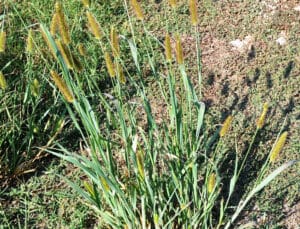Veronica serpyllifolia L.
Description
This species is often found growing in moist soils and shaded areas with thin turf. It tends to grow in diffuse patches and is most conspicuous when flowering during spring.
Life Cycle
Thyme-leaf speedwell is a member of the plantain family (Plantaginaceae) and is classified as a perennial. Plants produce stolons (runners) that creep in prostrate fashion and form new roots and leaves at nodes. This species produces flowers, fruits, and seeds during early to mid-spring.
Identification
Thyme-leaf speedwell stems are hairless, and initially grow close to the ground then turn upright, giving rise to flowers and seed-bearing fruits. Flower stems do not branch and can grow up to 12 inches tall. Leaves are oval or oblong and grow opposite one another on stems. Lower leaves are larger (½ to 1 inch in length and about a ½ inch wide) than leaves growing on upper portions of stems. Leaf margins of thyme-leaf speedwell are smooth, and leaf surfaces lack hairs; whereas common field speedwell and corn speedwell have serrated leaf margins and leaves with hairs on the surface. Flowers develop on stalks that arise from leaf axils on stems and are very small, usually 1/8 to 1/4 inch across. Each flower has four white petals (one petal is smaller than the others) with dark blue or purple longitudinal stripes. Like other speedwells, each flower has two stamens and a single style. Thyme-leaf speedwell flowers are replaced by heart-shaped fruits that contain seeds.
Cultural Control
The occurrence of thyme-leaf speedwell can be reduced by improving turf density through fertilization, regular mowing, and the use of turfgrasses well-adapted to site conditions. This weed can be suppressed or controlled with various preemergence and postemergence herbicides.





